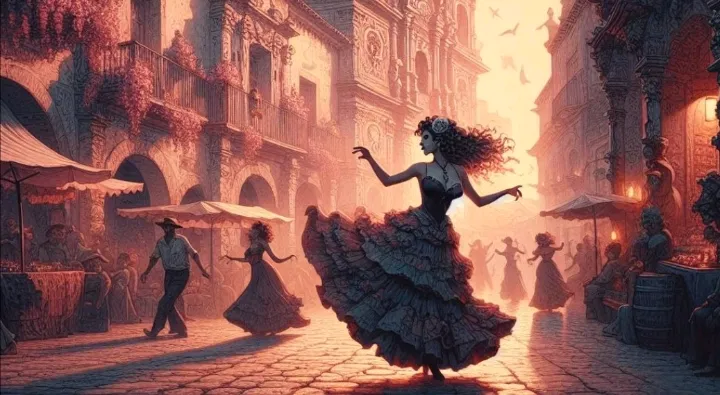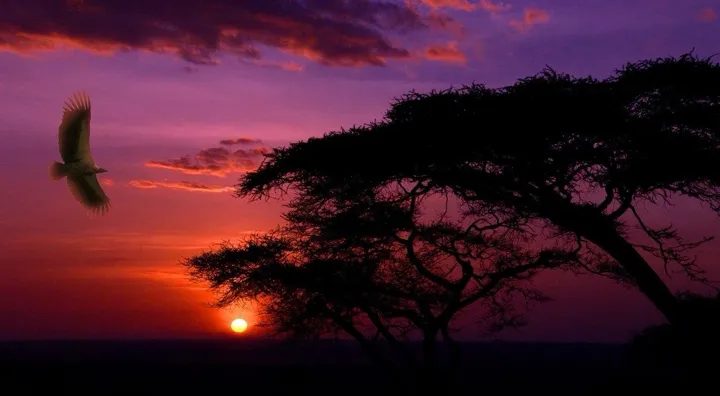La Bailarina del Alba / The Dancer of the Dawn
La Bailarina del Alba (Spanish version)
1920, Madrid, España
En un pequeño callejón del viejo Madrid, donde la luz del alba apenas se filtraba entre los edificios decrépitos, vivía Mariana, una joven con alma de fuego y pies de viento. Desde niña, su única compañía había sido la música, una melodía invisible que solo ella podía escuchar y que la impulsaba a bailar con una gracia salvaje y libre.
Cada mañana, cuando el sol teñía de rosa las fachadas, Mariana se deslizaba por el callejón y se dirigía a la Plaza Mayor. Allí, bajo la atenta mirada de las gárgolas y los vendedores ambulantes, danzaba con frenesí, dejando que la música la guiara por un universo de emociones.
Los madrileños la observaban con recelo. Algunos la llamaban "la loca del baile", otros murmuraban que estaba hechizada. Para ellos, sus movimientos eran espasmódicos, su alegría incomprensible. No podían escuchar la música que la llenaba, la melodía que vibraba en su corazón y la convertía en un torbellino de colores y ritmo.
Un día, un joven poeta llamado Miguel se detuvo a observarla. A diferencia de los demás, no vio locura en sus ojos, sino una pasión ardiente, una entrega total al ritmo. Se quedó embelesado, hipnotizado por la danza de Mariana, y al terminar, se acercó a ella con timidez.
"Bailas como si el viento te llevara", le dijo Miguel con una sonrisa.
Mariana lo miró con sorpresa, era la primera vez que alguien le hablaba sin burla o miedo.
"Es la música", respondió ella con voz suave. "La música me habla, me cuenta historias, me lleva a lugares lejanos".
Esa fue la primera vez que hablaron. Miguel, con su alma sensible y su mente abierta, comprendió la pasión de Mariana y se convirtió en su confidente, en su amigo, en el único que podía escuchar la música que la habitaba.
Con el tiempo, el amor floreció entre ellos. Miguel le escribía poemas inspirados en sus danzas, y Mariana bailaba con más fervor al sentir las palabras del poeta resonando en su corazón. Juntos, crearon un mundo propio, un universo donde la música era el lenguaje del alma y la danza una forma de expresión libre y pura.
A pesar del amor que los unía, Mariana no abandonó su baile en la Plaza Mayor. Seguía danzando al alba, con la misma pasión y entrega, desafiando las miradas de incomprensión. Pero ahora, en sus ojos brillaba una luz diferente, la luz del amor y la esperanza.
Un día, mientras Mariana bailaba con los primeros rayos de sol, un grupo de artistas la observó con fascinación. Eran pintores, músicos y poetas que buscaban nuevas formas de expresión, y en la danza de Mariana encontraron la libertad y la creatividad que anhelaban.
La invitaron a unirse a ellos, a compartir su arte con el mundo. Mariana aceptó con entusiasmo, y juntos crearon un espectáculo único, donde la música, la pintura y la danza se fusionaban en una explosión de color y movimiento.
El éxito fue rotundo. El público se conmovió con la pasión de Mariana y la belleza de su baile. La "loca del baile" se convirtió en la musa de los artistas, en un símbolo de libertad y creatividad.
Mariana nunca dejó de escuchar la música que la habitaba. Siguió danzando hasta el final de sus días, contagiando a todos con su alegría y pasión. Y aquellos que la vieron bailar, aquellos que se abrieron a la posibilidad de escuchar la música invisible, comprendieron que la verdadera locura es negar la belleza que vive en el corazón.
The Dancer of the Dawn (English version)
1920, Madrid, Spain
In a small alleyway of old Madrid, where the light of dawn barely filtered between the decrepit buildings, lived Mariana, a young woman with a fiery soul and feet of the wind. Since childhood, her only company had been music, an invisible melody that only she could hear and that impelled her to dance with a wild and free grace.
Every morning, when the sun tinged the facades with pink, Mariana would slip down the alleyway and head to the Plaza Mayor. There, under the watchful eye of the gargoyles and street vendors, she would dance with frenzy, letting the music guide her through a universe of emotions.
The people of Madrid watched her with suspicion. Some called her "the crazy dancer," others whispered that she was bewitched. To them, her movements were spastic, her joy incomprehensible. They could not hear the music that filled her, the melody that vibrated in her heart and turned her into a whirlwind of colors and rhythm.
One day, a young poet named Miguel stopped to watch her. Unlike the others, he saw no madness in her eyes, but a burning passion, a total surrender to the rhythm. He was captivated, hypnotized by Mariana's dance, and when she finished, he approached her timidly.
"You dance as if the wind were carrying you," Miguel said with a smile.
Mariana looked at him in surprise. It was the first time someone had spoken to her without mockery or fear.
"It's the music," she replied softly. "The music speaks to me, tells me stories, takes me to faraway places."
That was the first time they spoke. Miguel, with his sensitive soul and open mind, understood Mariana's passion and became her confidant, her friend, the only one who could hear the music that inhabited her.
Over time, love blossomed between them. Miguel wrote poems inspired by her dances, and Mariana danced with more fervor as she felt the poet's words resonating in her heart. Together, they created a world of their own, a universe where music was the language of the soul and dance a form of free and pure expression.
Despite the love that united them, Mariana did not abandon her dance in the Plaza Mayor. She continued to dance at dawn, with the same passion and dedication, defying the looks of incomprehension. But now, a different light shone in her eyes, the light of love and hope.
One day, while Mariana was dancing with the first rays of sun, a group of artists observed her with fascination. They were painters, musicians, and poets who were looking for new forms of expression, and in Mariana's dance they found the freedom and creativity they longed for.
They invited her to join them, to share her art with the world. Mariana accepted with enthusiasm, and together they created a unique show, where music, painting, and dance merged in an explosion of color and movement.
The success was resounding. The audience was moved by Mariana's passion and the beauty of her dance. The "crazy dancer" became the muse of the artists, a symbol of freedom and creativity.
Mariana never stopped listening to the music that inhabited her. She continued dancing until the end of her days, infecting everyone with her joy and passion. And those who saw her dance, those who opened themselves up to the possibility of hearing the invisible music, understood that the real madness is to deny the beauty that lives in the heart.
© Roberto R. Díaz Blanco
1920, Madrid, España
En un pequeño callejón del viejo Madrid, donde la luz del alba apenas se filtraba entre los edificios decrépitos, vivía Mariana, una joven con alma de fuego y pies de viento. Desde niña, su única compañía había sido la música, una melodía invisible que solo ella podía escuchar y que la impulsaba a bailar con una gracia salvaje y libre.
Cada mañana, cuando el sol teñía de rosa las fachadas, Mariana se deslizaba por el callejón y se dirigía a la Plaza Mayor. Allí, bajo la atenta mirada de las gárgolas y los vendedores ambulantes, danzaba con frenesí, dejando que la música la guiara por un universo de emociones.
Los madrileños la observaban con recelo. Algunos la llamaban "la loca del baile", otros murmuraban que estaba hechizada. Para ellos, sus movimientos eran espasmódicos, su alegría incomprensible. No podían escuchar la música que la llenaba, la melodía que vibraba en su corazón y la convertía en un torbellino de colores y ritmo.
Un día, un joven poeta llamado Miguel se detuvo a observarla. A diferencia de los demás, no vio locura en sus ojos, sino una pasión ardiente, una entrega total al ritmo. Se quedó embelesado, hipnotizado por la danza de Mariana, y al terminar, se acercó a ella con timidez.
"Bailas como si el viento te llevara", le dijo Miguel con una sonrisa.
Mariana lo miró con sorpresa, era la primera vez que alguien le hablaba sin burla o miedo.
"Es la música", respondió ella con voz suave. "La música me habla, me cuenta historias, me lleva a lugares lejanos".
Esa fue la primera vez que hablaron. Miguel, con su alma sensible y su mente abierta, comprendió la pasión de Mariana y se convirtió en su confidente, en su amigo, en el único que podía escuchar la música que la habitaba.
Con el tiempo, el amor floreció entre ellos. Miguel le escribía poemas inspirados en sus danzas, y Mariana bailaba con más fervor al sentir las palabras del poeta resonando en su corazón. Juntos, crearon un mundo propio, un universo donde la música era el lenguaje del alma y la danza una forma de expresión libre y pura.
A pesar del amor que los unía, Mariana no abandonó su baile en la Plaza Mayor. Seguía danzando al alba, con la misma pasión y entrega, desafiando las miradas de incomprensión. Pero ahora, en sus ojos brillaba una luz diferente, la luz del amor y la esperanza.
Un día, mientras Mariana bailaba con los primeros rayos de sol, un grupo de artistas la observó con fascinación. Eran pintores, músicos y poetas que buscaban nuevas formas de expresión, y en la danza de Mariana encontraron la libertad y la creatividad que anhelaban.
La invitaron a unirse a ellos, a compartir su arte con el mundo. Mariana aceptó con entusiasmo, y juntos crearon un espectáculo único, donde la música, la pintura y la danza se fusionaban en una explosión de color y movimiento.
El éxito fue rotundo. El público se conmovió con la pasión de Mariana y la belleza de su baile. La "loca del baile" se convirtió en la musa de los artistas, en un símbolo de libertad y creatividad.
Mariana nunca dejó de escuchar la música que la habitaba. Siguió danzando hasta el final de sus días, contagiando a todos con su alegría y pasión. Y aquellos que la vieron bailar, aquellos que se abrieron a la posibilidad de escuchar la música invisible, comprendieron que la verdadera locura es negar la belleza que vive en el corazón.
The Dancer of the Dawn (English version)
1920, Madrid, Spain
In a small alleyway of old Madrid, where the light of dawn barely filtered between the decrepit buildings, lived Mariana, a young woman with a fiery soul and feet of the wind. Since childhood, her only company had been music, an invisible melody that only she could hear and that impelled her to dance with a wild and free grace.
Every morning, when the sun tinged the facades with pink, Mariana would slip down the alleyway and head to the Plaza Mayor. There, under the watchful eye of the gargoyles and street vendors, she would dance with frenzy, letting the music guide her through a universe of emotions.
The people of Madrid watched her with suspicion. Some called her "the crazy dancer," others whispered that she was bewitched. To them, her movements were spastic, her joy incomprehensible. They could not hear the music that filled her, the melody that vibrated in her heart and turned her into a whirlwind of colors and rhythm.
One day, a young poet named Miguel stopped to watch her. Unlike the others, he saw no madness in her eyes, but a burning passion, a total surrender to the rhythm. He was captivated, hypnotized by Mariana's dance, and when she finished, he approached her timidly.
"You dance as if the wind were carrying you," Miguel said with a smile.
Mariana looked at him in surprise. It was the first time someone had spoken to her without mockery or fear.
"It's the music," she replied softly. "The music speaks to me, tells me stories, takes me to faraway places."
That was the first time they spoke. Miguel, with his sensitive soul and open mind, understood Mariana's passion and became her confidant, her friend, the only one who could hear the music that inhabited her.
Over time, love blossomed between them. Miguel wrote poems inspired by her dances, and Mariana danced with more fervor as she felt the poet's words resonating in her heart. Together, they created a world of their own, a universe where music was the language of the soul and dance a form of free and pure expression.
Despite the love that united them, Mariana did not abandon her dance in the Plaza Mayor. She continued to dance at dawn, with the same passion and dedication, defying the looks of incomprehension. But now, a different light shone in her eyes, the light of love and hope.
One day, while Mariana was dancing with the first rays of sun, a group of artists observed her with fascination. They were painters, musicians, and poets who were looking for new forms of expression, and in Mariana's dance they found the freedom and creativity they longed for.
They invited her to join them, to share her art with the world. Mariana accepted with enthusiasm, and together they created a unique show, where music, painting, and dance merged in an explosion of color and movement.
The success was resounding. The audience was moved by Mariana's passion and the beauty of her dance. The "crazy dancer" became the muse of the artists, a symbol of freedom and creativity.
Mariana never stopped listening to the music that inhabited her. She continued dancing until the end of her days, infecting everyone with her joy and passion. And those who saw her dance, those who opened themselves up to the possibility of hearing the invisible music, understood that the real madness is to deny the beauty that lives in the heart.
© Roberto R. Díaz Blanco
Related Stories






